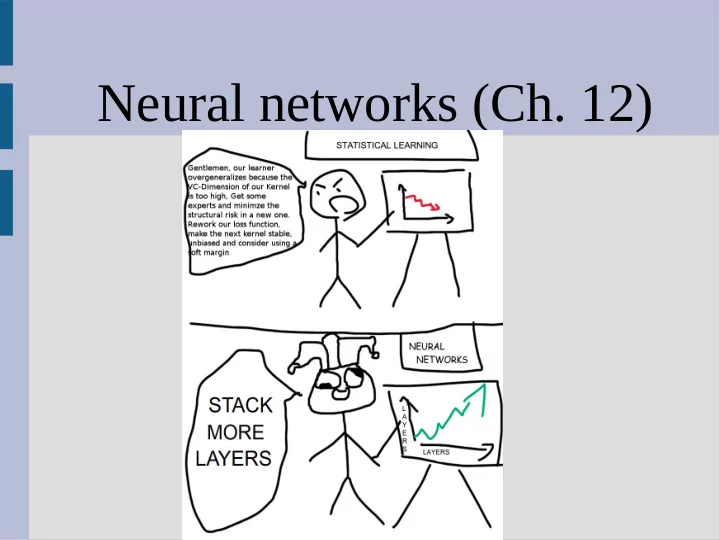

Neural networks (Ch. 12)
Back-propagation The neural network is as good as it's structure and weights on edges Structure we will ignore (more complex), but there is an automated way to learn weights Whenever a NN incorrectly answer a problem, the weights play a “blame game”... - Weights that have a big impact to the wrong answer are reduced
Back-propagation To do this blaming, we have to find how much each weight influenced the final answer Steps: 1. Find total error 2. Find derivative of error w.r.t. weights 3. Penalize each weight by an amount proportional to this derivative
Back-propagation Consider this example: 4 nodes, 2 layers w 1 w 5 out 1 in 1 3 1 w 3 w 7 w 6 w 2 out 2 in 2 2 4 w 4 w 8 b 1 b 2 1 This node as a constant bias of 1
Neural network: feed-forward One commonly used function is the sigmoid:
Back-propagation .4 out 1 in 1 .15 3 1 0.05 .5 .25 .45 .2 out 2 0.1 in 2 4 2 .55 .3 0.35 1 0.6 Node 1: 0.15*0.05 + 0.2*0.1 +0.35 as input thus it outputs (all edges) S(0.3775)=0.59327
Back-propagation .4 out 1 in 1 .15 3 1 0.05 .5 .25 .45 .2 out 2 0.1 in 2 4 2 .55 .3 0.35 1 0.6 Eventually we get: out 1 = 0.7513, out 2 = 0.7729 Suppose wanted: out 1 = 0.01, out 2 = 0.99
Back-propagation We will define the error as: (you will see why shortly) Suppose we want to find how much w 5 is to blame for our incorrectness We then need to find: Apply the chain rule:
Back-propagation
Back-propagation In a picture we did this: Now that we know w5 is 0.08217 part responsible, we update the weight by: w 5 ←w 5 - α * 0.08217 = 0.3589 (from 0.4) α is learning rate, set to 0.5
Back-propagation Updating this w 5 to w 8 gives: w 5 = 0.3589 w 6 = 0.4067 w 7 = 0.5113 w 8 = 0.5614 For other weights, you need to consider all possible ways in which they contribute
Back-propagation For w 1 it would look like: (book describes how to dynamic program this)
Back-propagation Specifically for w 1 you would get: Next we have to break down the top equation...
Back-propagation
Back-propagation Similarly for Error 2 we get: You might notice this is small... This is an issue with neural networks, deeper the network the less earlier nodes update
NN examples Despite this learning shortcoming, NN are useful in a wide range of applications: Reading handwriting Playing games Face detection Economic predictions Neural networks can also be very powerful when combined with other techniques (genetic algorithms, search techniques, ...)
NN examples Examples: https://www.youtube.com/watch?v=umRdt3zGgpU https://www.youtube.com/watch?v=qv6UVOQ0F44 https://www.youtube.com/watch?v=xcIBoPuNIiw https://www.youtube.com/watch?v=0Str0Rdkxxo https://www.youtube.com/watch?v=l2_CPB0uBkc https://www.youtube.com/watch?v=0VTI1BBLydE
NN examples AlphaGo/Zero has been in the news recently, and is also based on neural networks AlphaGo uses Monte-Carlo tree search guided by the neural network to prune useless parts Often limiting Monte-Carlo in a static way reduces the effectiveness, much like mid-state evaluations can limit algorithm effectiveness
NN examples Basically, AlphaGo uses a neural network to “prune” parts for a Monte-carlo search
Recommend
More recommend